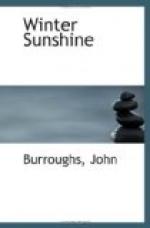Reynard is usually caught very lightly, seldom more than the ends of his toes being between the jaws. He sometimes works so cautiously as to spring the trap without injury even to his toes, or may remove the cheese night after night without even springing it. I knew an old trapper who, on finding himself outwitted in this manner, tied a bit of cheese to the pan, and next morning had poor Reynard by the jaw. The trap is not fastened, but only encumbered with a clog, and is all the more sure in its hold by yielding to every effort of the animal to extricate himself.
When Reynard sees his captor approaching, he would fain drop into a mouse-hole to render himself invisible. He crouches to the ground and remains perfectly motionless until he perceives himself discovered, when he makes one desperate and final effort to escape, but ceases all struggling as you come up, and behaves in a manner that stamps him a very timid warrior,—cowering to the earth with a mingled look of shame, guilt, and abject fear. A young farmer told me of tracing one with his trap to the border of a wood, where he discovered the cunning rogue trying to hide by embracing a small tree. Most animals, when taken in a trap, show fight; but Reynard has more faith in the nimbleness of his feet than in the terror of his teeth.
Entering the woods, the number and variety of the tracks contrast strongly with the rigid, frozen aspect of things. Warm jets of life still shoot and I play amid this snowy desolation. Fox-tracks are far less numerous than in the fields; but those of hares, skunks, partridges, squirrels, and mice abound. The mice tracks are very pretty, and look like a sort of fantastic stitching on the coverlid of the snow. One is curious to know what brings these tiny creatures from their retreats; they do not seem to be in quest of food, but rather to be traveling about for pleasure or sociability, though always going post-haste, and linking stump with stump and tree with tree by fine, hurried strides. That is when they travel openly; but they have hidden passages and winding galleries under the snow, which undoubtedly are their main avenues of communication. Here and there these passages rise so near the surface as to be covered by only a frail arch of snow, and a slight ridge betrays their course to the eye. I know him well. He is known to the farmer as the “deer mouse,” to the naturalist as the white-footed mouse,—a very beautiful creature, nocturnal in his habits, with large ears, and large, fine eyes full of a wild, harmless look. He is daintily marked, with white feet and a white belly. When disturbed by day he is very easily captured, having none of the cunning or viciousness of the common Old World mouse.




